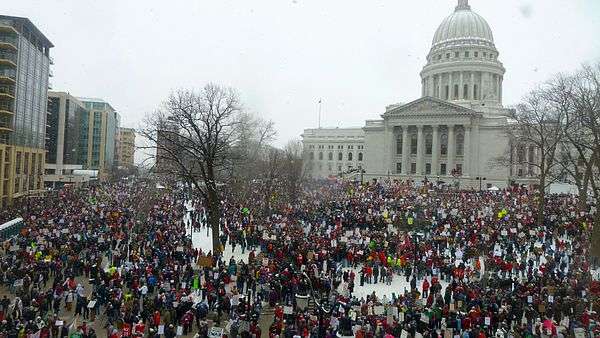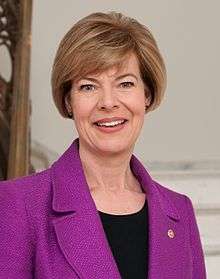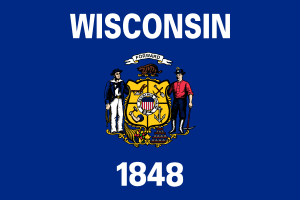Democratic Party of Wisconsin
The Democratic Party of Wisconsin is the affiliate of the Democratic Party in the U.S. state of Wisconsin. It is currently headed by state party chair Ben Wikler.
Democratic Party of Wisconsin | |
|---|---|
 | |
| Chairman | Ben Wikler |
| Governor | Tony Evers |
| Senate minority leader | Jennifer Shilling |
| House minority leader | Gordon Hintz |
| Headquarters | Madison, WI |
| Ideology | Wisconsin Idea[1] Modern liberalism Social liberalism |
| National affiliation | Democratic Party |
| Colors | Blue |
| U.S. Senate (Wisconsin seats) | 1 / 2 |
| U.S. House (Wisconsin seats) | 3 / 8 |
| Statewide offices | 5 / 5 |
| Seats in the Wisconsin Senate | 14 / 33 |
| Seats in the Wisconsin Assembly | 36 / 99 |
| Website | |
| www | |
| |
History
Pre-civil war
The Democratic Party dominated politics until the late 1850s, followed by the newly founded Republican Party of Wisconsin. The Republican Party held sway for almost 100 years. Jacksonian democracy was strong in Wisconsin in the early days, until 1856 all territorial and state governors were Democrats, except for one Whig. In 1854, however, a coalition of Whigs, Antislavery Democrats, and Free Soilers formed a Republican Party in the state—a key event in the establishment of the national Republican Party.[2] From that point on, Republicans quickly gained control of most elected offices; from 1856 to 1959 there were only three Democratic governors. This period of time would last almost one hundred years, until the Democratic party would gain a stronger foothold within the state.
Late 19th century
In the late 19th century, the Republican Party was primarily concerned with the special interests of railroads, the lumber industry and the concerns of unionized labor.[3] Along with these interests and the Republicans' ability to accumulate Federal funding for Wisconsin, gained the Republicans the support of many individuals in the working class, along with small business and Populist farmers. In the last decade of the 19th century, the Republican Party's progressive base, which was led by Robert La Follette, began to dominate Wisconsin state politics. The election of La Follette as governor in 1900 was the cornerstone of this movement. Democrats were virtually dormant in the state during this time.
20th century
The Republicans led by La Follette employed many progressive policies within in the state of Wisconsin. These policies during the twentieth century were rather influential with the masses, and helped spur their later success in the state of Wisconsin.[3] The Republicans' tight control of Wisconsin politics lasted until the 1950s, when Democrats altered some aspects of their party to become more aligned with the national party. These changes were consistent with the new social policies being called for by the national Democratic Party. The Democrats won their first major victory when William Proxmire was elected in the late 1950s. Wisconsin in the 1980s and early 1990s was characterized by competitive two-party politics for control of the governorship, other state constitutional offices, the state legislature, and U.S. Senate seats. [4]
21st century
The dawn of the 21st century has been a mixed one when it comes to control of state politics. The Democrats and Republicans in Wisconsin have both had multiple occasions of controlling either the State Assembly or the State Senate. The first decade of the twenty-first century has been an even balance between the parties fight for control of Wisconsin. During most of the 2010s, the Democrats were not in control of the governor's office, the Assembly, or the Senate.[5] However in 2018, Democrat Tony Evers won the Governorship.
Ideology
The Democratic Party of Wisconsin tends to be closely aligned with many of the ideas/ideologies of the national Democratic Party in the United States. While the national Democratic Party has a wider scope of views, the Democratic Party of Wisconsin shares many of the same views which fall under the same ideology. The Wisconsin Democratic Party's ideologies can be classified as liberal and progressive. Many of these views can be characterized by what the party is calling for relating to the party's social ideals and economic ideals. This can encompass topics such as education, healthcare, foreign policy, environmental issues and labor.
Many of these issues are addressed when the Party has their convention and they develop and vote on a party platform. The most recent party platform was created and voted on during the 2016 presidential election
Controversy
In February 2011 the Republican-controlled state legislature, proposed the "2011 Wisconsin budget repair bill" also endorsed by Governor Scott Walker caused much controversy within the Democratic Party and the state of Wisconsin. The debate over first-term Republican Governor Scott Walker's call to stop just short of eliminating collective bargaining for most public employees divided Wisconsin and prompted a walkout by all 14 Senate Democrats.[6] A group of State Senators fled the state to halt the vote on the bill by denying a quorum. The fourteen were Tim Carpenter, Spencer Coggs, Tim Cullen, John Eprenbach, Dave Hansen, Jim Holperin, Robert Jauch, Chris Larson, Julie Lassa, Mark Miller, Fred Risser, Lena Taylor, Kathleen Vinehout, and Robert Wirch. The repair bill ultimately passed after a series of appeals and judicial rulings. An unsuccessful movement to recall Governor Walker began and ended in 2012.

Elected officials
Democrats hold all statewide offices in Wisconsin. The following is a list of Democratic statewide, federal, and legislative office holders as of January 7, 2019:
Members of Congress
Democrats comprise 4 of Wisconsin's 10-member Congressional delegation - including the Class I US Senator seat and 3 members of the House of Representatives.
U.S. Senate
Democrats have controlled Wisconsin's Class I seat in the U.S. Senate since 1957:
- Class I: Tammy Baldwin (Junior Senator, United States Senate Democratic Conference Secretary)
 Junior Senator Baldwin
Junior Senator Baldwin
U.S. House of Representatives
Out of the 8 seats Wisconsin is apportioned in the U.S. House of Representatives, 3 are held by Democrats:
Statewide constitutional officers
State Senate
|
|
State Assembly
|
|
|
Mayoral offices
- City of Milwaukee: Tom Barrett
- City of Madison: Satya Rhodes-Conway
- City of Green Bay: Eric Genrich
- City of Kenosha: John Antaramian
- City of Racine: Cory Mason
- City of La Crosse: Tim Kabat
- City of Manitowoc: Justin Nickels
- City of Superior: Jim Paine
- City of Glendale: Bryan Kennedy
County parties
The Democratic Party of Wisconsin is a membership organization.[7] Members are organized in 71 county Democratic parties in Wisconsin. Ashland and Bayfield counties are organized as the joint Chequamegon Democratic party.[8]
Chairs
- James Edward Doyle (1951–1953), United States District Court Judge for the Western District of Wisconsin (1965–1980)
- Patrick Lucey (1957–1963), Governor of Wisconsin (1971–1977) and United States Ambassador to Mexico (1977–1979)
- Herb Kohl (1975–1977), U.S. Senator from Wisconsin (1989–2013)
- Matt Flynn (1981–1985), retired partner at Quarles & Brady and candidate for Governor of Wisconsin in 2018
- Jeffrey A. Neubauer (1989–1993), State Representative (1981–1989)
- Joe Wineke (2005–2009), Wisconsin State Senator for the 27th District (1993–1999)
- Martha Laning (2015–2019), former nonprofit executive and activist
- Ben Wikler (2019–present), current chair
See also
References
- "Tony Evers won as the Wisconsin Idea candidate". The Cap Times. 2018-11-11. Retrieved 2020-01-31.
- Kinnell, Susan K. The Democratic and Republican Parties in America a historical bibliography. Santa Barbara, Calif.: ABC-Clio Information Services, 1984.
- Alice Honeywell (1984). La Follette and His Legacy (PDF). Robert M. La Follette School of Public Affairs. Retrieved April 4, 2018.
- Moakley, Maureen. Party realignment and state politics. Columbus: Ohio State University Press, 1992.
- "Archived copy" (PDF). Archived from the original (PDF) on 2014-05-02. Retrieved 2011-12-06.CS1 maint: archived copy as title (link)
- WALTERS, STEVEN. 2011. "Showdown in Madison", State Legislatures 37, no. 7: 20. MasterFILE Premier, EBSCOhost (accessed December 5, 2011).
- "Constitution and Bylaws - Democratic Party of Wisconsin". www.wisdems.org. Retrieved 4 April 2018.
- "County Parties - Democratic Party of Wisconsin". www.wisdems.org. Retrieved 4 April 2018.
